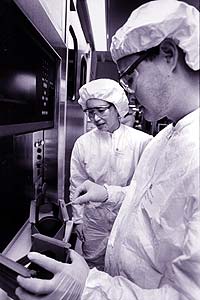Turning things around
How engineering increased its number of female faculty
| 6 February 2003
 Associate professor of electrical engineering Tsu-Jae King, left, is one of a growing number of women hired by the College of Engineering in recent years. (Peg Skorpinski photo) |
When Professor Alice Agogino first joined the College of Engineering faculty in 1984, she was an anomaly: a female in an overwhelmingly male department and college. But that was as expected; she had long since resigned herself to the fact that female mechanical engineers, like herself, were few and far between.
It was only later — because of her young daughter — that she began to question faculty hiring practices that helped perpetuate the isolation of women in her field. "I wanted things to be different for her, should she decide to become a professor when she grows up," Agogino says.
A first step was to bring women faculty together to talk
about their experiences in the college. "I heard some real horror stories about discrimination in the hiring process," Agogino says of the group’s initial meetings. "Some
incidents were pretty blatant, while others were more subtle."
Spurred on by the accounts they shared, the women engineers went on a fact-finding mission, to see if the data supported their experiences. Among the startling statistics they uncovered: of the 39 new faculty hired between 1996 and 2000, 37 were men and only 2 were women.
Read more stories from the Berkeleyan's Faculty Diversity
package |
Turning things around, it developed, would require changes in the college’s recruitment, interview, and hiring procedures, as well as in its cultural climate. As an example of the latter, 50 photos of retired engineering professors — all white and male — lined one wall of a heavily used seminar room in Etcheverry Hall. These have been removed, so that female and minority faculty and students don’t feel alienated.
The committee also developed guidelines designed to promote faculty gender equity. Among them were:

